Motichur laddu are soft, delish melt in the mouth ladoo made mainly with gram flour, sugar, and spices. The gram flour batter is fried to make tiny balls or boondi and mixed with sugar syrup, nuts or seeds and later shaped to neat round balls. Motichoor ladoo is a popular sweet from the North Indian cuisine and often made during festivals or celebrations. Here I share my detailed step-by-step photos to make these soft, tender and tasty homemade laddu recipe from scratch.
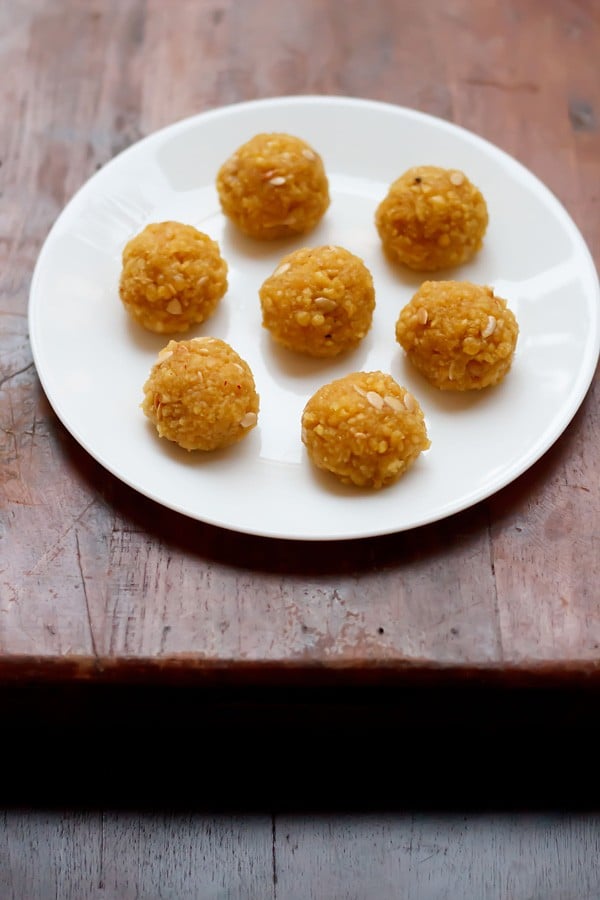
About Motichoor Ladoo
In the Hindi language, the word ‘Moti’ means pearl and ‘Choor or Chur’ means to crush or crumble. Literally translated to crumbled pearls. The term ‘laddu or ladoo’ refers to sweetened round balls.
Actually, when you hold this ladoo in your hand and even apply a little pressure, they crumble. They are so soft and delicate that while eating also they fall apart.
The hero ingredient here is gram flour. It is also known as besan in Hindi and made from skinned black chickpeas.
Note that the gram flour is chickpea flour in the sense that chickpea flour is made with white chickpeas. For the recipe use the finer variety of gram flour and not the coarser variety.
The recipe is time intensive but not difficult. You will need certain equipment to make this laddu as I have shown in the stepwise photos.
I have not purchased anything special and made use of what I had in the kitchen. Most of these equipments can be easily found in an Indian kitchen.
Generally the motichur ladoo that you get in mithai shops (sweets shops) have green, red or orange color boondi in the ladoo.
For that they make extra batches of colored boondis with artificial colors. Here I have used saffron as a natural coloring agent. I try to avoid artificial coloring agents as far as I can.
If you plan to make the motichur laddu, for any deity or for pooja, then I do suggest adding a pinch of edible camphor in them.
You can also fry the boondi in ghee. Generally, most food offered for bhog or naivedyam, are made in cow’s ghee. Desi ghee has a satvik quality and hence used for religious purposes.
If you have a pooja or any religious activity at home, then these motichur laddu, can be given as prashad to the devotees. Usually, four small ladoo are given in one pack.
Motichur Laddu vs Boondi Ladoo
The major difference between Boondi ladoo and motichoor ladoo is the size of the tiny boondi or fried gram flour balls. Boondi ladoo has the gram flour balls bigger in size and motichoor ladoo has smaller ones.
Both the ladoo are made from gram flour or besan batter. The batter is poured through a ladle or sieve with perforations and these give rise to round shaped droplets, called as boondi (derived from the word ‘boond’ in Hindi which means water droplets).
There are two types of boondi ladoo. One is a soft textured one and the other is a crisp hard one. Both these ladoo varieties have some variations in the method, thus yielding different textures.
Making motichoor ke ladoo is easy but time-consuming. I already know the process as I have seen Halwais (traditional sweet makers) preparing the ladoo a couple of times.
I have a photographic memory so I still remember the whole process in my mind. But for finer details and points, I asked my mother-in-law and referred to Lavi’s post Here.
The whole process of making the motichur laddu took a lot of time and in between, it started becoming dark. By the time, I was finished, it was already dark. The laddu were so good, we could not resist having them.
So after some ladoo were over, I took the photos the next day of the remaining laddu. Again next day, with a lot of things happening during the festive occasion, I ended up taking the final photos just before sunset. Hence the final photos have not come out well.
Thus, I was not sure of adding these motichur laddu recipe on the blog. Two days back, my husband bought some motichur ladoo from a famous mithai shop nearby and asked me to taste it and compare with the ones I had made.
We came to a conclusion that the homemade motichur laddu were much superior in taste, texture and flavor than the mithai shop ones. I don’t want to boast but that was our genuine feeling.
The laddu made at home were more softer and tasty. So my husband told me, don’t deprive your readers from this delicious motichur laddu recipe.
What hubby said, made sense and so I am adding the motichoor ladoo recipe. I hope you enjoy making them and eating them.
How to make Motichoor Ladoo
Make Sugar Syrup & Batter
1. Dissolve sugar, saffron threads and water in a pan and keep it on the stovetop to prepare the sugar syrup. Keep on a low to medium-low heat to cook the sugar solution.
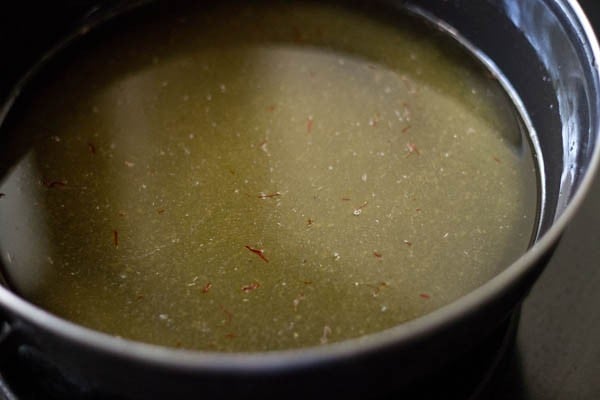
2. Make a smooth flowing batter of the gram flour/besan, crushed saffron and water. The batter should neither be thick nor thin. It should be a flowing batter as shown below.
The amount of water to be added depends on the quality of the gram flour. So you can add more or less than, what is mentioned in the recipe.
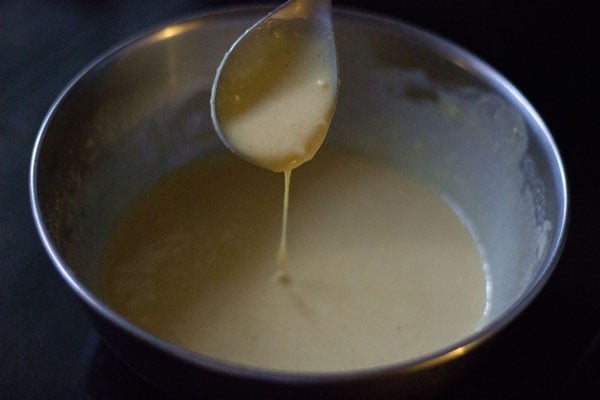
3. In the below photo the sugar solution is simmering. Stir at intervals.
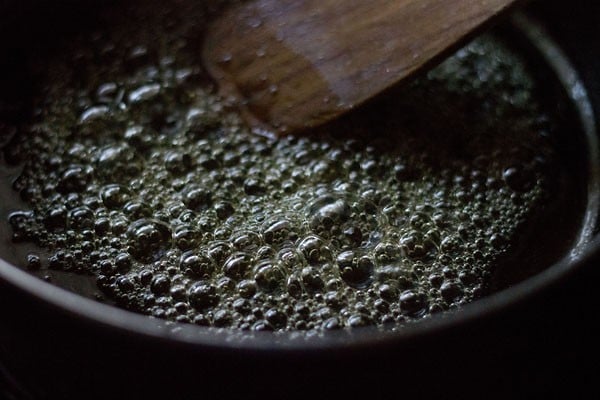
4. Cook the sugar syrup till you get one thread consistency in it (see the photo below showing one thread consistency) and then switch off the heat.
Remove the pan from the stovetop and set it aside on your kitchen countertop.
Remember that the sugar syrup should be hot when you add the boondi to it. So you can keep the sugar solution in a hot water bath.
Meaning place the pan on a plate or tray filled with hot water. This will keep it hot without crystallizing it.
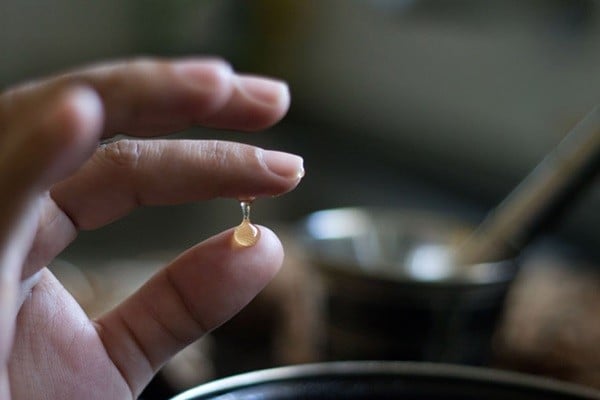
Make Boondi
5. Heat oil for deep frying in a kadai or pan. The oil has to be moderately hot. When you add one or two drops of the gram flour batter, they should come up briskly but steadily on the surface.
If they come up very quickly, then the oil is very hot. If they don’t come up or take time, the oil is not enough hot.
Take a perforated ladle/spoon. With your hands position the ladle above the oil. You will need one more large ladle/jhara to remove the fried boondis.
Remember to fry the boondi in a medium-hot oil or a moderately hot oil. If the oil is warm, the boondi will soak more oil, getting loaded and soggy with it.
If the oil is very hot, the batter will get more browned or even burnt becoming very crispy.
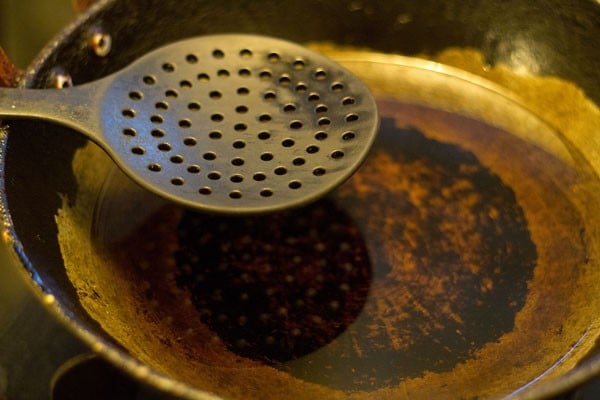
6. Take a large spoon of the besan batter and pour it on perforated ladle/spoon. Press with the other spoon so that the batter falls down from the perforations into the hot oil.
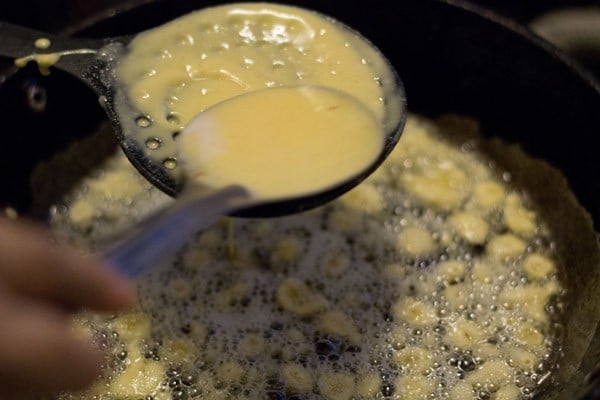
7. Fry the boondi (gram flour balls) till they become golden. Don’t over fry or make them crisp. When the oil stops sizzling, remove the boondis.
About 45 seconds to 1 minute is enough to get the correct texture in the boondi. This step is important because if boondi becomes crisp then motichoor laddu won’t be soft and they won’t be able to absorb the sugar syrup.
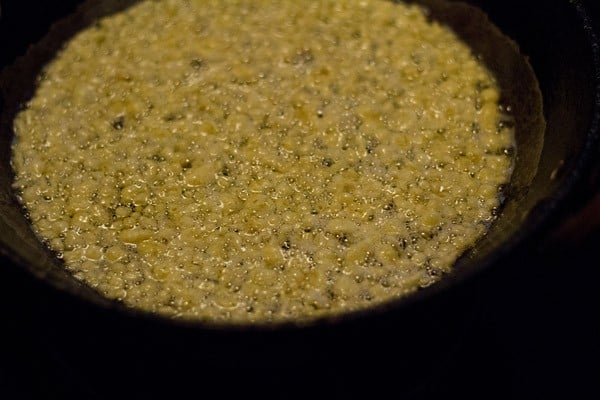
8. For collecting the fried boondi use a large slotted spoon/jhara. Drain the oil very well after removing the boondi and then add them directly to the sugar syrup.
Also, note that the sugar syrup should be hot. If the sugar syrup is not hot, then just heat it.
In case, the sugar syrup crystallizes, then reheat again mixing 1 to 2 tablespoons water.
No need to bother about the flat or tailed boondis as we will be pulsing them in the blender later.
Fry the boondi in batches this way and keep on adding them after draining the oil very well to the hot sugar syrup.
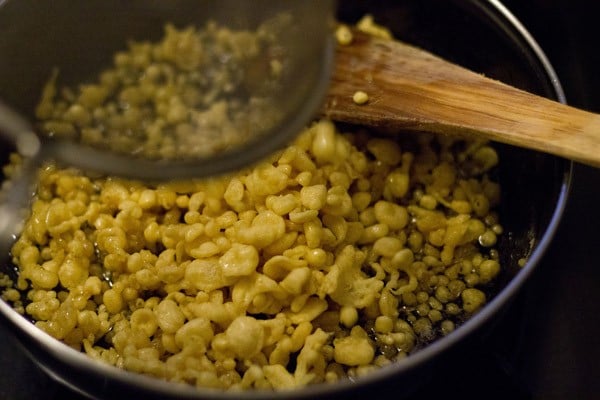
9. Make all the boondis like this and keep on adding boondis immediately to the sugar syrup. Stir and mix well. The boondis should get softened in the sugar syrup.
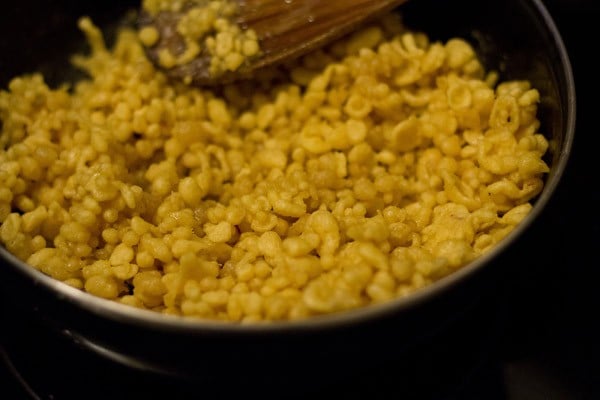
Make Motichur Laddu
10. In a blender or mixer add all of the boondi that has been mixed with the sugar syrup. Add 1 tablespoon of hot water and pulse the boondi mixture a few times to get a smaller shape.
Don’t pulse too much otherwise you won’t be able to shape the motichoor laddu easily.
The amount of water to be added depends on the texture of the boondis. If the boondis are a bit crisp, then add 1 or 2 tablespoons more of the hot water. The boondis absorb the hot water and remain soft and moist.
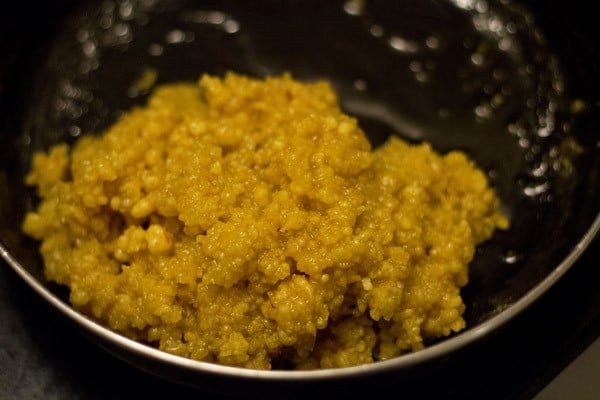
11. Add the magaz (melon seeds) and black cardamom seeds. Mix well.
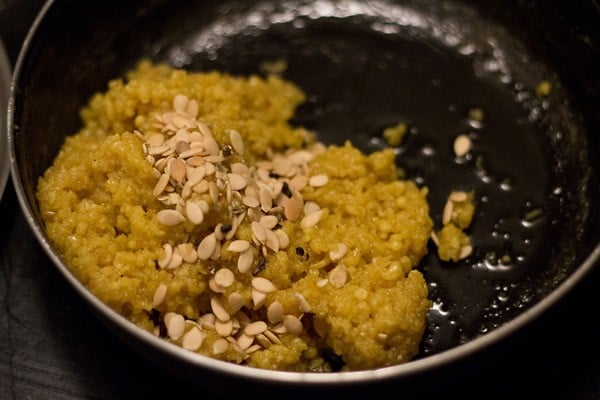
12. Apply some oil or ghee on your palms and shape the ladoo. The mixture would be warm when preparing the laddu. On cooling they become firm.
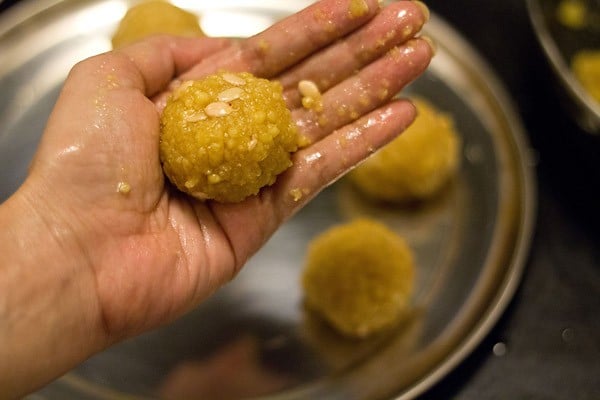
You can garnish them with melon seeds/magaz or raisins or nuts like almond or pistachio slivers. These ladoo can also be refrigerated.
If you fry them in ghee then the ghee will solidify on refrigeration and some softness is lost. Enjoy them as soon as they are made and store leftovers in the refrigerator.
For more sweets recipes you can check this post sharing 121 Sweets for Diwali festival.
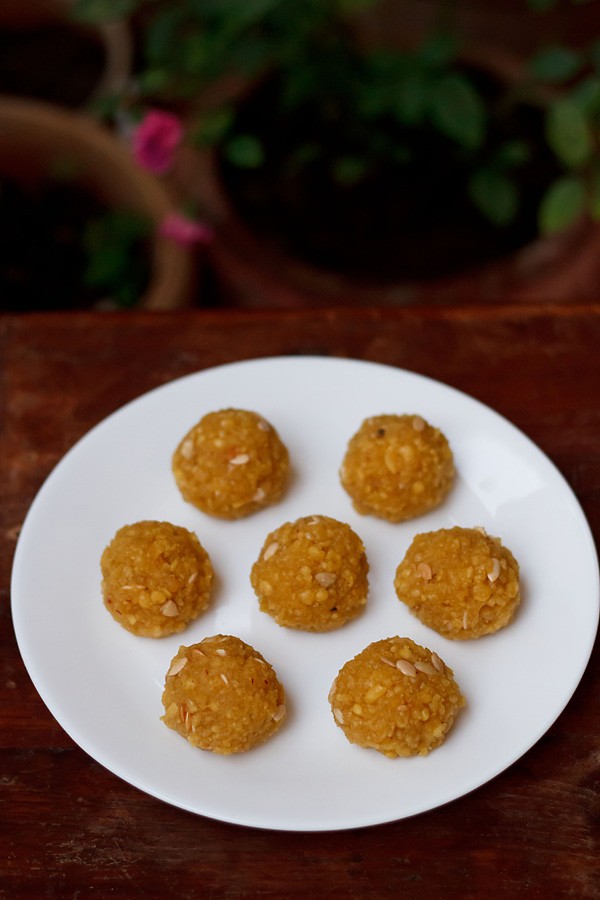
Expert Tips
- The batter should be smooth flowing and without lumps and of medium consistency.
- One thread consistency in sugar solution and keep it hot.
- Don’t over fry the boondis or make them crisp. They should be soft and cooked and not crisp.
- Sugar syrup should be hot when you add boondis to them.
- Add fried boondis immediately to the sugar syrup.
- Don’t pulse the boondis too much in mixer. Otherwise you won’t be able to shape the motichur ladoo easily.
If you are looking for more Ladoo Recipes then do check:
Please be sure to rate the recipe in the recipe card or leave a comment below if you have made it. For more vegetarian inspirations, Sign Up for my emails or follow me on Instagram, Youtube, Facebook, Pinterest or Twitter.
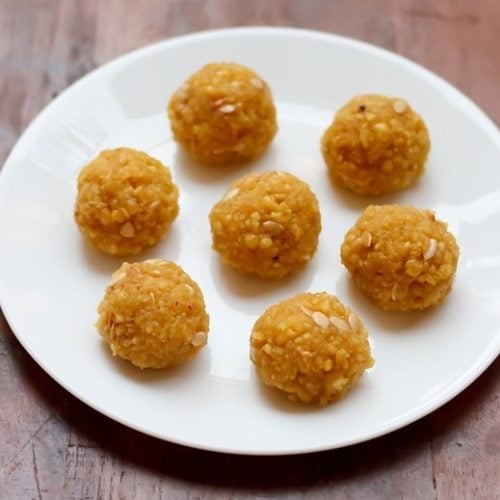
Motichur Laddu Recipe (Motichoor Ladoo)
Ingredients
For sugar syrup
- 1 cup sugar
- ½ cup water
- a generous pinch of saffron powder or crushed saffron (kesar)
For making boondi
- 1 cup besan (gram flour)
- a generous pinch of saffron powder or crushed saffron (kesar)
- ¾ cup water
- 2 to 3 black cardamoms – seeds removed and the skins discarded
- ½ tablespoon magaz (melon seeds)
- oil for deep frying
- a bit of oil or ghee for applying on the palms while shaping the ladoo
Instructions
Preparing sugar syrup
- Dissolve sugar, saffron threads and water in a pan and keep it on the stove top.
- Cook the sugar solution till it reaches one thread consistency (check step 3 pic to see photo showing one thread consistency) and then switch off the flame. Keep the sugar solution aside.)
Making boondi
- Make a smooth flowing batter of the gram flour/besan, crushed saffron and water. The batter should neither be thick nor thin. It should be a flowing batter without any lumps. The amount of water to be added depends on the quality of the the gram flour. So you can add more or less than what is mentioned in the recipe.
- Heat oil for deep frying in a kadai or pan. The oil has to be moderately hot. Take a perforated ladle/spoon. With your hands position the ladle above the oil. You will need one more large ladle/jhara to remove the fried boondis.
- Take a large spoon of the besan batter and pour it on perforated ladle/spoon. Press with the other spoon so that the batter falls down from the perforations into the hot oil.
- Fry the boondi (gram flour balls) till they become golden. Don’t over fry or make them crisp. When the oil stops sizzling, remove the boondis. About 45 seconds to 1 minute is enough to get the correct texture in the boondi.
- This step is important because if boondi becomes crisp then motichur laddu won't be soft and they won't be able to absorb the sugar syrup.
Making motichoor ladoo
- For collecting the fried boondi use a large slotted spoon/jhara. Drain the oil very well after removing the boondi and then add them directly to the sugar syrup. Also note that the sugar syrup should be hot.
- If the sugar syrup is not hot, then just heat it. In case, the sugar syrup crystallizes, then reheat again mixing 1 to 2 tablespoons water. No need to bother about the tailed or flat boondis as we will be pulsing them in the blender later.
- Make all the boondis like this and keep on adding them immediately to the sugar syrup. Stir and mix well. The boondis should get softened in the sugar syrup.
- In a blender or mixer add the boondi and the sugar syrup. Add 1 tablespoon of hot water and pulse the boondi mixture for a few times to get a smaller shape.
- Don't pulse too much otherwise you won't be able to shape the motichur laddu. The amount of water to be added depends on the texture of the boondis.
- If the boondis are a bit crisp, then add 1 or 2 tablespoons more of the hot water. The boondis absorb the hot water and remain soft and moist.
- Add the magaz/melon seeds and black cardamom seeds. Mix well.
- Apply some oil or ghee on your palms and shape the motichoor ladoo. The mixture would be warm when preparing the laddu. On cooling they become firm.
- You can garnish the motichoor ladoo with melon seeds/magaz or raisins. These motichur ladoo can also be refrigerated since they are not made from ghee. If you fry them in ghee then the ghee will solidify on refrigeration.
Notes
- Use a finer variety of gram flour and which is in its shelf life. Do not use gram flour that has got rancid.
- Remember to keep the sugar syrup hot by placing the pan over a bowl or pan of hot water.
- Don’t over fry the boondi. They should not become crisp.
- While blending do not pulse too much as the ladoo mixture will become pasty and won’t have the fine boondi in it.
- Fry the boondi in a medium hot oil. If the oil is warm, the boondi will soak more oil and become soggy with it. If the oil is very hot, the boondi will become crisp too soon and get too much browned or burnt.
- For a vegan motichoor laddu, use a neutral flavored oil to spread on your palms while shaping ladoo.
- The recipe can be scaled easily to make a small or large batch of motichur laddu.
Nutrition Info (Approximate Values)
Motichur Laddu recipe from the blog archives was first published on July 2014.
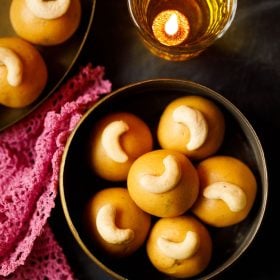
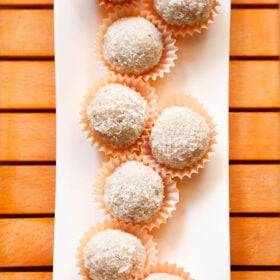
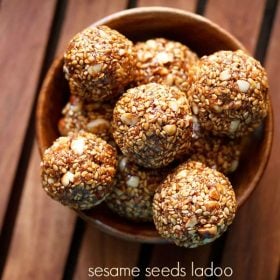
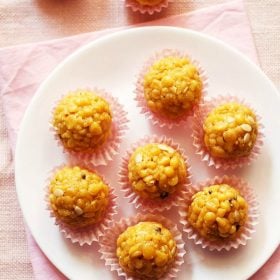








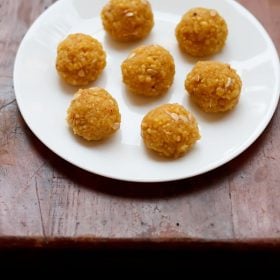
Thank you so much 👍 awesome recipe ❤️
Welcome and thanks.
Hi Dassana,
Thanks for an amazing recipe! Actually my son insisted to make these laddooes when I was going through your recipe. I tried it out and it turned out to be really delicious! But I also had a small problem while making those bundies. Using Jara when I was making bundies, there were lumps also! I tried with thicker batter also but it happened again. Though I was not worried that much as we were going to churn it in the final step!
But like you, even I love cooking and anything imperfect hits my head and I can’t get over with it until it is done perfectly!! So writing to you.
Hope will be able to understand the mistake I must have made while making those bundies!
I am following your recipes since 3-4 years and I am a big fan of yours.
Hi Ami, thanks for writing and yes I can understand. When mixing the batter use a small wired whisk as it really helps in dissolving small tiny lumps. Sometimes there is more moisture in the besan and this leads to lumps when mixing. You can sift the besan a couple of times before making the batter. You can even lightly roast the besan.
The stickiness in the lumps is due to the fact that most manufacturers use dried white peas flour in besan. Besan made with only chana dal won’t give troubles with the lumps. I used to grind chana dal in a local mill for making besan. I lightly roast the chana dal to get rid of moisture if any and then would be given to grinding in a local chakki. Trust me the pakoras or any dish you make with this homemade besan is much better than store-brought besan and does not even get lumps while mixing. I hope this helps.
Thanks a lot.
Hi Dassana , Thankyou for this recipe.I have made this many times and its always a hit.
Thanks for letting me know. Glad to read the feedback. Thanks for the rating too.
Hi, all your recipes are too good.. I tried it and the batter formed lumps when dropped in oil.. what could be the reason for that ?
thank you. while frying, the oil needs to be hot. if the oil is not hot, then lumps will form. another reason could be that the batter was more thin. this can also result in lumps. hope this helps.